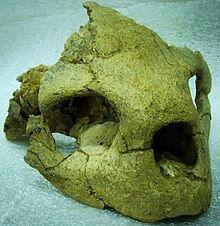Pacifichelys
| Pacifichelys | |
|---|---|

| |
| Skull of Pacifichelys urbinai | |
| Scientific classification | |
| Kingdom: | |
| Phylum: | |
| Class: | |
| Order: | |
| Suborder: | |
| Superfamily: | |
| Genus: | Pacifichelys
|
| Type species | |
| Pacifichelys urbinai Parham and Pyenson, 2010
| |
| Species | |
| |
| Synonyms | |
| |
Pacifichelys is an extinct genus of sea turtle from the Middle Miocene of Peru (Pisco Formation) and California (Temblor Formation).[1][2] It was first named by James F. Parham and Nicholas D. Pyenson in 2010, and the type species is Pacifichelys urbinai from Peru.[2] A second species, P. hutchisoni, was reassigned from the genus Euclastes. It is known from the Miocene of California. Like the living Ridley and Loggerhead sea turtles, Pacifichelys was durophagous, consuming hard-shelled organisms with crushing jaws.[2]
Taxonomy
Cladogram based on Lynch and Parham (2003)[3] and Parham and Pyenson (2010):[2]
| Cheloniidae sensu lato |
| |||||||||||||||||||||||||||||||||||||||||||||||||||
References
- ^ Pacifichelys at Fossilworks.org
- ^ a b c d James F. Parham; Nicholas D. Pyenson (2010). "New Sea Turtle from the Miocene of Peru and the Iterative Evolution of Feeding Ecomorphologies since the Cretaceous". Journal of Paleontology. 84 (2): 231–247. doi:10.1666/09-077R.1.
{{cite journal}}: CS1 maint: multiple names: authors list (link) - ^ Lynch, S.C.; Parham, J.F. (2003). "The first report of hard-shelled sea turtles (Cheloniidae sensu lato) from the Miocene of California, including a new species (Euclastes hutchisoni) with unusually plesiomorphic characters" (PDF). PaleoBios. 23 (3): 21–35.[permanent dead link]
- ^ http://paleodb.org/cgi-bin/bridge.pl?action=checkTaxonInfo&taxon_no=165647&is_real_user=0
